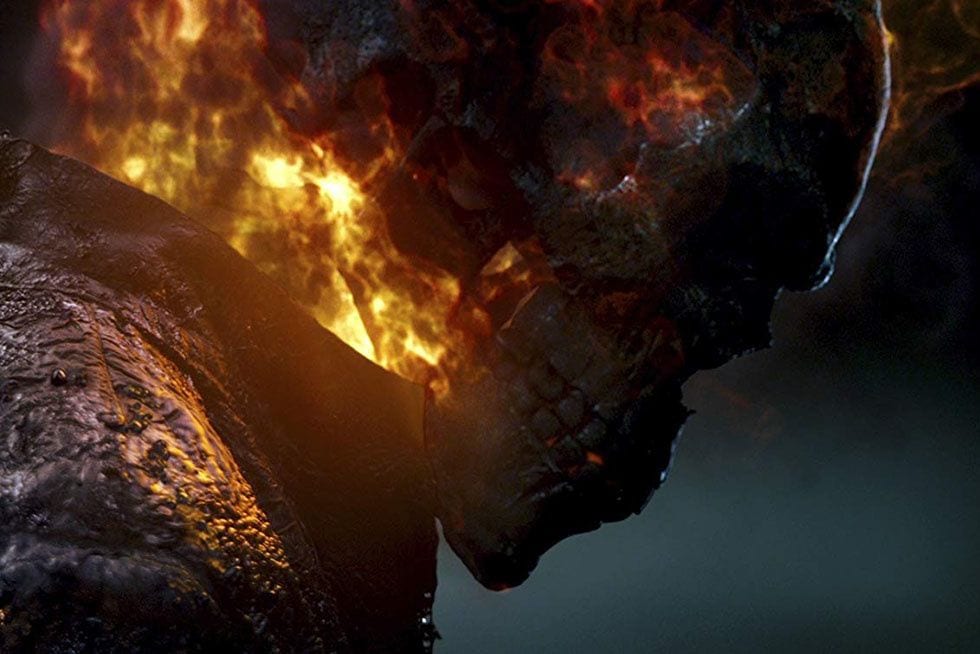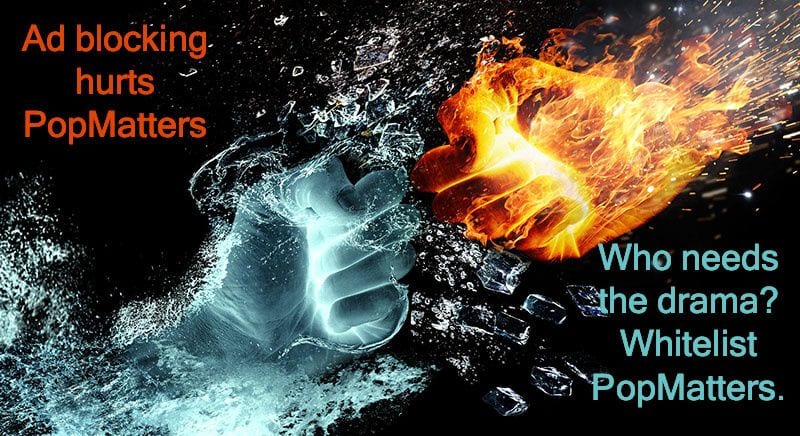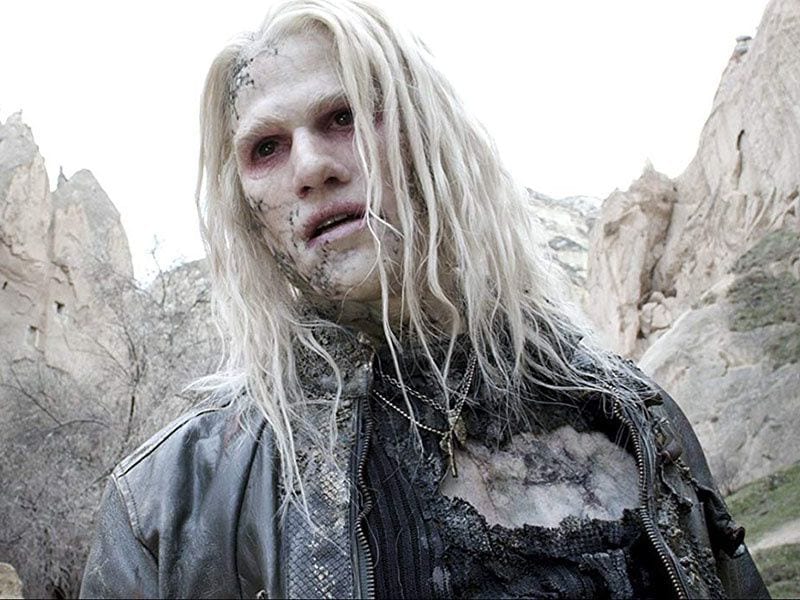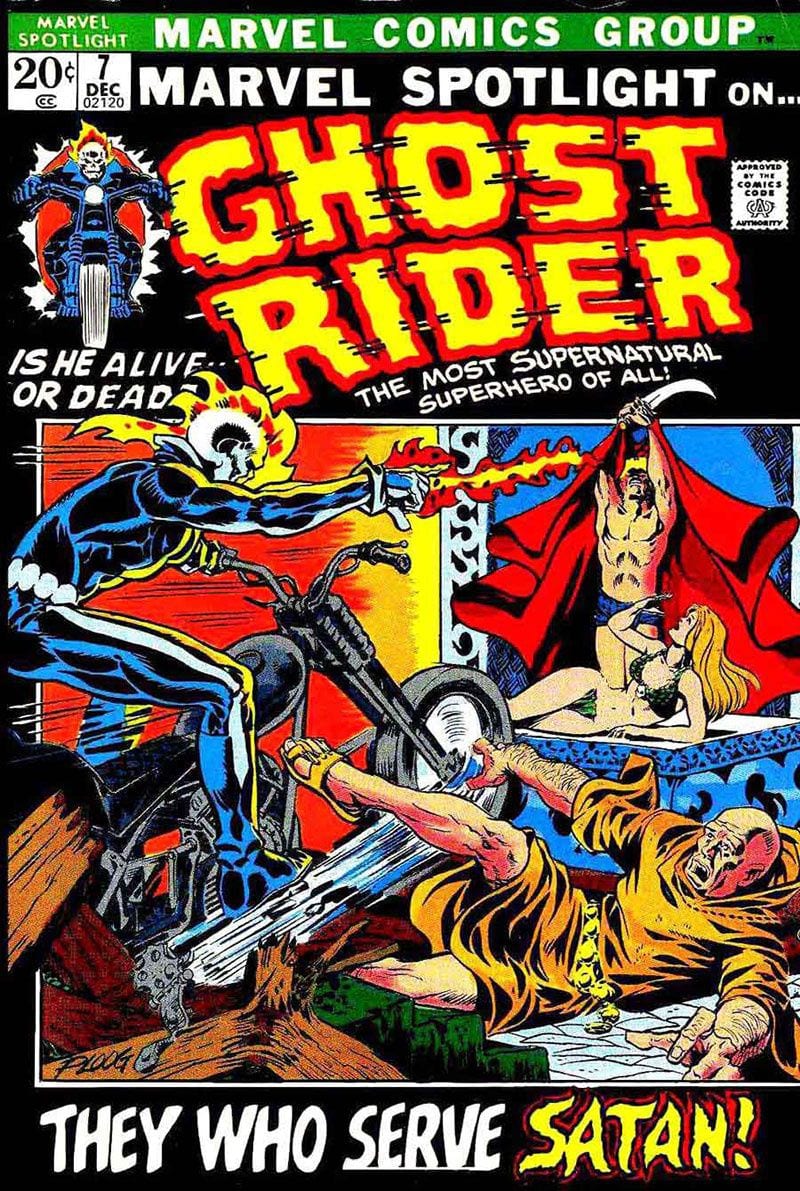Why make a sequel to Ghost Rider (Johnston, 2007)? The property had only been fitfully popular over its nearly 40-year history, and never had same the staying power as most of Marvel’s stable of characters. The first film, starring Nicholas Cage as Johnny Blaze/Ghost Rider, was moderately successful, but was not particularly well-liked by critics or audiences. Since its release, the fifth ongoing Ghost Rider series was cancelled with Ghost Rider Vol. 5 #35 (July 2009) due to low sales. Sure, shortly before the release of Ghost Rider, producer Avi Arad had announced that they were making plans for a sequel, but that’s standard for superhero films. The producers could have walked back that claim in light of a seeming lack of interest for another film. Ultimately, I think the reason is that comic book films had become the biggest genre in Hollywood, and the Ghost Rider property had some name recognition. Nicholas Cage was still a huge star, and was willing to return to the series. And so, although it took a longer-than-usual five years, Ghost Rider: Spirit of Vengeance (Neveldine/Taylor, 2012) was produced.
The best thing that I can say about this sequel is that the filmmakers tried something different, stylistically. Cage was, indeed, willing to return, but he requested the tone be darker than the bland first film. The producers hired David S. Goyer, who had previously worked on the Blade trilogy for Marvel before moving over to the Dark Knight trilogy for Warner Bros., to write the first version of the script. Back in 2000, Goyer wrote a Ghost Rider script that everyone seems to agree was fantastic. But that film would have been R-rated and Sony Pictures, the studio behind both Ghost Rider films, was not willing to make an R-rated superhero film. The fact that it was rated PG-13 has emerged as the main excuse for people involved with Spirit of Vengeance to explain its failure.
For the record, an R-rating, meaning potentially more profanity, violence, sexuality or drug use, does not automatically make a film better. If a film is lacking a strong central plot, characters, theme (the basics of good storytelling), adding more gore and nudity may distract from the shortcomings, but it will not fix them. I believe that Deadpool (Miller, 2016) and Logan (Mangold, 2017) would have been excellent films if they had been rated PG-13 because they were solid films at their core. So please stop saying that superhero films or horror films will magically be better with an R-rating. But, I digress.
Goyer wrote a different screenplay for Spirit of Vengeance, partially inspired by the success of Dan Brown novels such as The Da Vinci Code (2003). Goyer includes secret religious orders and European backdrops, which were popular in the Brown novels. Although there are no direct connections to the first Ghost Rider film, and the character’s origin was mildly tweaked, Goyer views Spirit of Vengeance as a follow-up. He set the film eight years later, with Johnny Blaze hiding out in eastern Europe, allowing the character to be in a darker, more existential emotional place than in the first film. The film was officially announced in July 2010, over three years after the release of the first film, and Cage was confirmed to be returning. Most importantly, however, was the announcement of the directors.
A trend has emerged in Hollywood, over the past decade or so, of studios hiring successful independent or dramatic filmmakers with unique styles to direct major blockbusters. The logic is that these filmmakers may lack experience with certain aspects of blockbuster filmmaking (such as directing action or working with visual effects) but they will infuse a potentially generic blockbuster with their own strengths (such as strong writing, character work, unique visual approach, or quirky sense of humour) to bring freshness to the genre. The studio surrounds these filmmakers with a crew that can guide them through their new challenges, and they can deliver a stylistically different blockbuster. Marvel Studios, in particular, has become known for successfully implementing this approach with such films as Guardians of the Galaxy (Gunn, 2014), Thor: Ragnarok (Waititi, 2017) and Black Panther (Coogler, 2018). With Spirit of Vengeance, the studio and producers hired the directing duo of Mark Neveldine and Brian Taylor, credited as Neveldine/Taylor, to bring their unique, visceral visual style to the Ghost Rider series.
Neveldine and Taylor made their debut with Crank (Neveldine/Taylor, 2006), a frenetic, gratuitous action film that has become something of a cult classic since its release. They followed that film up with Crank: High Voltage (Neveldine/Taylor, 2009) and Gamer (Neveldine/Taylor, 2009), with seemingly diminishing returns. They quickly became known for their visceral, hands-on cinematography style, which is typically handheld and constantly in motion. They are the kinds of filmmakers who will shoot while wearing rollerblades, or while riding a motorcycle, or while hanging off a cliff to inject more energy into shots. In an interview with Blake J. Harris for Slashfilm in 2016, Taylor opened up about his and Neveldine’s poor work ethic and substance abuse while filming Gamer. He claims to have cleaned up, but regrets possibly wasting the rare opportunity to direct films by being, well, wasted. It’s likely that these issues played a role in Neveldine and Taylor’s particular brand of extreme, physical filmmaking. And honestly, if Spirit of Vengeance is any indication, their tricks do more to obscure and sap energy from the action, than enhance it. The cinematography and editing are sloppy and unrefined while not actually making things more kinetic or visceral. But by hiring them the producers were at least attempting to bring a different kind of energy to the series.
Spirit of Vengeance ends up being a bit of a mixed-bag. Certain elements work better in this film than the first one, such as the more-defined relationship between Blaze and the Ghost Rider, and the sense of constant propulsion from beginning to end. But the style, though unique for the superhero genre, detracts from the overall film. Furthermore, the tone is uneven, and can never quite overcome the silliness of its premise. The result of the sloppy filmmaking and uneven tone is a film that is pure B-movie. It’s a trashy, fitfully entertaining but forgettable action film that is a far cry from the polished studio comic book films that had become increasingly common in Hollywood.
The film opens with a priest, Moreau (Idris Elba), riding his motorcycle to a monastery in the mountains of Romania to warn them about an imminent attack. The monastery has been harbouring Nadya (Violante Placido) and her 12-year-old son Danny Ketch (Fergus Riordan). Danny Ketch is the name of the character who popularly succeeded Johnny Blaze as Ghost Rider in the comics during the ’90s, but here he is the child of the devil. Nadya once made a deal with the devil, here referred to as Roarke (Ciarán Hinds), to avoid death, and he impregnated her with Danny. Now, as Danny’s thirteenth birthday approaches, Roarke hires Carrigan (Johnny Whitworth), a former lover of Nadya’s, to kidnap Danny for a ceremony that will transfer Roarke’s essence into the boy. Moreau believes that Johnny Blaze/Ghost Rider (Nicholas Cage) is the only one who can stop Roarke and save Danny. This backstory is doled out gradually between the action in a fairly relentless film.
The monastery is immediately attacked, and Carrigan’s men chase Nadya and Danny. Moreau recruits Johnny, promising to cure him of the Ghost Rider curse if he protects Danny. Carrigan catches up to Nadya and manages to escape with Danny when the Ghost Rider attacks. Johnny teams up with Nadya to locate Danny again, and the Ghost Rider decimates Carrigan and his men the second time. Roarke arrives and gives the dying Carrigan powers of decay with which he can combat the Rider. Meanwhile, Moreau leads Johnny, Nadya and Danny to another hidden monastery. As he breaks Johnny’s curse with surprising ease, the monks, led by Methodius (Christopher Lambert), attempt to kill Danny to stop Roarke’s plans. The monks are killed by Carrigan, who takes Danny to Roarke for the ceremony.
Despite losing his Ghost Rider powers, Johnny insists on rescuing Danny. He, Moreau and Nadya track down Roarke to a castle in Turkey, where his followers have assembled to witness him passing his essence into Danny. Johnny and Moreau sneak in, but Moreau is killed and Johnny is captured. Danny uses his “son of the devil” powers to return Johnny’s Ghost Rider powers, however, and Roarke tries to escape. The Ghost Rider chases him down, kills Carrigan, saves Danny, and sends Roarke back to Hell. And then, with the mission over, the film ends immediately and unceremoniously.
A story such as this, filled with fantastical or pseudo-religious elements, is typically presented in one of two ways: with complete, straight-faced conviction, or with a jokey detachment. The former method requires complete commitment and emotional honesty from the writers and the actors, but it runs the risk of being unintentionally laughable if it misses the mark. The latter method is far more common in Hollywood these days, and it typically requires a character from outside of the fantastical world who can comment incredulously on the proceedings. Ghost Rider: Spirit of Vengeance cannot seem to decide which approach it wants to take, and it ends up somewhere in the middle, making the film tonally uneven. The main problem is there’s no character who’s outside of the world that can comment on the insanity, the audience surrogate. Johnny and Nadya both made deals with the devil (Roarke), Danny is the result of one of the deals, the son of the devil, and Moreau is a priest who battles these supernatural threats. The only character who could reasonably be expected to react with appropriate surprise to all of the film’s shenanigans is Carrigan, an ordinary mercenary hired by Roarke, but he accepts everything pretty fast. And so, with no appropriate character to call out strange occurances, the screenwriters decided to use an inappropriate character: Johnny Blaze.

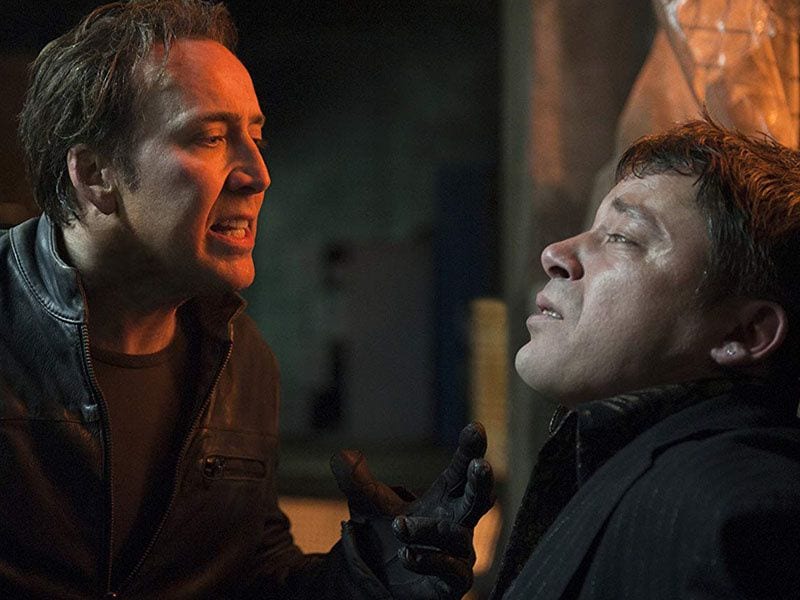
Cage’s performance as Blaze is all over the place which, sadly, was what audiences expected from Cage at this stage of his career. Some of the time, he plays Johnny dramatically, as a man haunted by his curse and guilt over ruining his life. In these scenes, his character feels fully integrated into the world and takes everything seriously. At other times, he plays a manic version, barely holding in the insane demon that has possessed him. These are the most “Nicholas Cage” moments in the film, full of crazed intensity and laughing fits. They are often punctuated by cartoonish CGI moments of bulging eye sockets or half-skull faces or fire spouting from his nose, as if the Ghost Rider skull is pushing its way out of his face. The performance is over-the-top and the accompanying visuals are terrible. But the most problematic moments from a tonal perspective are the times the screenplay calls on Johnny to act surprised by what’s occurring. This is a man who occasionally transforms into a flaming-skull motorcycle demon, but he raises an eyebrow at Nadya’s deal with Roarke or at Danny exhibiting powers. These moments of Johnny’s jokey detachment, which come in dialogue scenes as well as in voiceover, undermine the film by preventing it from fully committing to its silly premise. The tone ultimately feels sort of juvenile as a result. The story is told like an insecure teenager recounting a cool fantasy story to his friends, but cracking jokes about it to feign a cool detachment.
There are also some issues with the characterization of Johnny and the Ghost Rider. First of all, to nitpick: Ghost Rider (Johnson, 2007) ends with Johnny refusing to give up his curse so that he can use it to fight Mephistopheles/Roarke. In Ghost Rider: Spirit of Vengeance, Johnny is motivated by the prospect of ridding himself of the curse. This is a nitpick because Spirit of Vengeance feels mostly disconnected from Ghost Rider. The character’s motivations in this film contradict his big, heroic decision at the end of the first film. Spirit of Vengeance also wedges in some additional mythology for the character that never really lands. Before taking away Johnny’s curse, Moreau explains that he’s possessed by Zarathos, which was once an Angel of Justice but was corrupted into being a Demon of Vengeance. At the very end of the film, Danny seems dead from a car crash. Johnny says that he can feel the Angel of Justice inside of him, his hand starts burning with blue fire instead of orange fire, and he resurrects Danny. The film ends seconds later, making this turn of events go completely unexplained. How did the nature of the spirit possessing Johnny change so suddenly? Did Johnny’s heroism somehow change the nature of the demon possessing him? Who cares, the bad guys are dead, movie over!
Some aspects of the film are vast improvements over Ghost Rider, however. First of all, I was disappointed that the relationship between Johnny and the Ghost Rider was so undefined in the first film. That issue is solved here. The screenwriters make it very clear that the Ghost Rider is a demon that’s possessing Johnny, and that he has no control once it comes out. In that way, the film develops Johnny’s character along the lines of Bruce Banner/the Hulk, and his true heroism lies in trying to keep the monster at bay. The screenwriters also use the tried-and-true superhero sequel trope of stripping the hero of his powers part way through to demonstrate that he’s a hero even without them. This concept has been used, and done better, in such films as Superman II (Lester, 1980), Spider-Man 2 (Raimi, 2004) and The Wolverine (Mangold, 2013). Despite the predictability of how it plays out, I appreciated the approach. I also feel like the filmmakers nailed the Ghost Rider look this time. Its skull is charred black in this film, as opposed to white in the first film and in the comics. It makes it much more striking on screen. His jacket looks like melted, bubbling tar, which is another nice touch. The demeanour of the Ghost Rider is also more interesting, as he’s played like an insane demon. He takes sadistic joy in creatively dispatching villains by eating a clip full of bullets and then spraying them back as molten sludge, or commandeering a giant mining vehicle, transforming it into a fiery version of the machine. These are fun touches and improve on the the dullness of Ghost Rider.
Overcoming dullness seemed to be the primary goal of Spirit of Vengeance, explaining the hiring of Neveldine and Taylor. The film has the barest of introductions before the first monastery is attacked by Carrigan’s men and it ends, as I said, immediately after the main villain is dispatched. In between is a lean, 90-minute chase of a film with very little downtime. Although I appreciate the approach, and enjoyed the film more than Ghost Rider, I still felt disengaged and checked the time twice while watching this film. And that’s because no amount of flashy camerawork, editing or pyrotechnics can distract from an uninteresting plot.
But let’s talk about that flashy camerawork, editing and pyrotechnics, shall we? This was my first, and thus far only, Neveldine/Taylor film (although I am keen to see the Crank films at some point). So I was interested to examine their style. Their approach to cinematography is restless, constantly shaking from being handheld, always moving in the shot, often whip-panning around a scene. The position of the camera is typically at a low angle, giving the impression of the camera operator holding the camera down at his or her side and tilting it up to the actors’ faces. As if the shooting style was not frenetic enough, the editing is also rapid, and the directors make occasional use of the speed-ramping effect (sudden speeding up, then slowing down). All of these techniques are meant to give the film an extra sense of energy, but they do not. In fact, the primary effect of all of this flashiness is obscuring the action. The poor angles, shakiness, constant movement and editing make it more difficult to see what’s happening. So rather than be engaged by what’s occurring on-screen, viewers detach themselves and check the time.
I realized this during a scene in the middle of the film, when Johnny tries to cheer Danny up by taking Danny onto his motorcycle and doing tricks. There’s so much going on with the camerawork and the editing that it’s hard to see which tricks Johnny’s doing. This should have been a fun, sweet scene, but I had no idea what was happening. Its followed by the second monastery sequence, in which Johnny is cured and the monks nearly kill Danny. All of the scenes at this monastery are shot with a soft focus and blown-out lighting which, once again, obscure whats on screen. It’s like the directors realized these scenes were heavy on dialogue and short on action, meaning that their typical handheld style and quick-cutting would be inappropriate, so they needed another trick to make the visuals unwatchable. There are also the scenes in which Carrigan uses his powers of decay to kill people. During these attacks, the screen irises in on his victims and the focus softens. It’s an interesting effect but, like most of the other interesting effects, it obscures what’s occurring.
The producers took a chance on Neveldine and Taylor to create something different from other superhero films, and Ghost Rider was the appropriate character for them to tackle. And yet, their interesting visual style comes off as sloppy. Incidentally, Mark Neveldine and Brian Taylor ended their partnership after this film, and have moved on to solo projects. The reasons for the split are unclear, but the reception to this film couldn’t have helped.
The budget of Ghost Rider: Spirit of Vengeance was about half of Ghost Rider, and it made about half of the box office. The film ended its theatrical run with $52 million in North America and $133 million worldwide. Reviews were unkind, and I tend to agree. This is a trashy B-movie, more entertaining than the boring Ghost Rider but still not well-made or cohesive. In advance of the film, Marvel Comics launched a new Ghost Rider series in July 2011, but it was cancelled after nine issues in March 2012, one month after the release of Spirit of Vengeance. There was initial rumblings of a third Ghost Rider film, but no one seemed particularly committed. Not even Marvel Studios, which reacquired the film rights to Ghost Rider in May 2013 and immediately stated that there were no plans to make a new Ghost Rider film. A new version of the character, in which the demon possesses Robbie Reyes, debuted in All-New Ghost Rider #1 (May 2014). This version of the character debuted in the fourth season of Marvel’s Agents of SHIELD on September 2016. And so, following in the footsteps of Daredevil, Blade, The Punisher, it seems that the cinematic journey of Ghost Rider has come to an end.
***
Stan Lee Cameo Corner: No Stan Lee cameo here. That’s 14 cameos in 25 films, or 56 percent of Marvel Films up to this point. That’s surprisingly low, considering the perception that he cameos in nearly every film.
Next Time: “And there came a day, a day unlike any other, when Earth’s mightiest heroes and heroines found themselves united against a common threat. On that day, The Avengers were born — to fight the foes no single super hero could withstand!”

